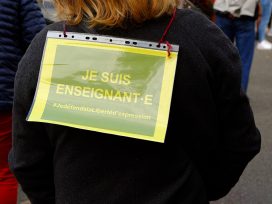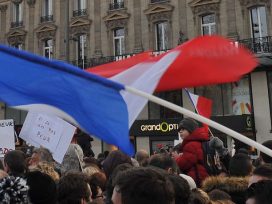I do not think many Swedes would readily recognize the name Taimour Abdulwahab. Possibly it may give rise to vague feelings of discomfort at the back of some people’s minds. I, myself, was in Stockholm city when Abdulwahab blew himself to pieces on Drottninggatan on 11 December last year. He first detonated a car bomb and then his own explosive belt in the midst of the on-going Christmas shopping. Had he managed to implement his initial plan he could have injured and killed hundreds of people. We still don’t know – and we may never know – why he detonated the bombs prematurely, whether it was by mistake or if he staged a last minute withdrawal from the plan. The image of his dead body lying on a snow-covered street in Stockholm can be easily accessed on the Internet. He was the only one to die.
Almost a year has passed and very little is known about the reasons behind his actions. He was a “normal” guy, a young man from Tranås, who had not shown any specific religious or political concerns at school – not until 2001 when in Luton and with the Islamist groups at the University. According to his family his change was sudden and dramatic.
One name, however, that most Swedes would recognize is the name of Peter Mangs, the man who was detained in Malmö a few weeks prior to Abdulwahab’s suicide bombing in Stockholm. Mangs is charged of three murders and thirteen attempts of murder, where the victims share one common trait: either they or their parents were born outside of Sweden. Despite the fact that Mangs probably is one of the most notorious political assassinators in modern Swedish history – the “laserman” John Ausonious has been convicted of one murder and nine attempts of murder – he disappeared completely from the headlines after the suicide bombing in Stockholm. Mangs is one of the worst kinds of racist mass murderers of our time yet his name is not actively remembered.
And then there is Anders Behring Breivik. These three, Abdulwahab, Mangs and Breivik, have nothing much in common apart from their conviction that they for purely ideological reasons regard themselves as having the right to kill people indiscriminately – to murder people whom they have never set eyes on before.
I am critical of comparing different kinds of evil. If one begins to compare Stalin’s terror regime to Hitler’s then one winds up counting dead bodies which paradoxically would come to set the one tyrant off as a “lesser evil” than the other. Thinking along these lines may result in a diminishing of the permanent damage they have implemented. The impulse, however, to compare things is almost instinctual – Abdulwahab versus Mangs. And more readily: Abdulwahab versus Breivik. Immediately, we recognize a danger inherent in this kind of comparison: which one of these two constitutes the “real” threat?
Nevertheless, this is precisely what the British writer Kenan Malik does in a rather interesting article published in Eurozine – he makes a direct comparison. Despite my initial apprehension I still find that Malik makes a few good points. He claims that the acts of violence that these two have committed are grounded in a “desperate and perverted search for identity, a search shaped by a sense of cultural paranoia, a cloying self-pity and a claustrophobic victimhood”. The similarity that he points out is that Abdulwahab and Breivik “both use the language of the ‘clash of civilizations’ to justify their atrocities”.
I want to linger for a moment on Malik’s observation of some kind of language-based justification by the perpetrator of the acts of killing people whom one has not met before. I want to examine further what this language base might be.
In an article in Dagens Nyheter I recently expressed the idea that a lonely madman is never just that – alone. They do not regard themselves as loners but instead as the implementers of a collective command: they are performing what “everyone wills” them to do. I do not think it possible to find a single political assassinator or mass murderer who has not thought of him/herself as belonging to an ideological and intellectual community. Extremist Islamicism such as the one Abdulwahab connected with in Luton is one such community. And in Breivik’s fragmented “manifesto” it is possible to find his “intellectual community”. People like me who have spent time going through parts of or all of his “manifesto” know that the worldview that he propagates cannot be termed Nazi – it is nationalist conservative and he expresses himself in a manner that belonged to conservative Swedish academics and politicians from around 1942. He also quotes notable amounts of sources – several of them Swedish and many of them websites and books that have had a major influence on the development of Swedish right wing extremism.
Breivik’s crime and the damage he has caused are unique in the history of the Nordic countries. Although it may be painful, we need to persistently continue to examine the event over a long period of time. If we want to ensure that Breivik does not succeed in his attempt to fundamentally change society, we must uphold the discussion about his deeds. In these coming years we must incessantly examine the ideas that informed him and the irrational hatred directed towards the social democrats that underlies the political murders in our part of the world. Claiming this to be the case does not turn it into a party issue, but instead it entails looking at the facts at hand.
However, I also note a similarity between Abdulwahab and Breivik, which Malik does not mention. The obvious link between the two is their hatred of modernity. They both express that their attacks against society aim to bring society back to an earlier undemocratic era. This is their goal. This is the same fear of modernity that we recognize from the Swedish nationalists who warned against democracy during the 1910s, ’20s and ’30s: democracy is a divisive force, it dissolves barriers and it brings the “wrong” kind of people into power. It allows the Other to enter the stage. Democracy is messy. It mixes things that should not be mixed. The opposite of democracy is purity.
A self critical conclusion we might draw from these events is that we have become unforgivably poor at talking about the content of the concept of democracy: openness, equality, freedom of speech. All these terms have been allowed to depreciate into ceremonial concepts that taste of Eternity and Heaven. We must understand that democracy in our part of the world is still young. This year, in Sweden, we are commemorating the ninetieth anniversary of our first democratic elections. Despite this we still take most of the ideological content of democracy for granted – until we are confronted with an attack on our democratic society. The words of Jens Stoltenberg, to meet violence with more democracy, more openness, more humanism, were exactly the right words in the centre of the crisis. But how do we go about this?
In more ways than I am willing to admit I have had my worldview shaped by the 1980s – the decade that ended in 1989 and the fall of the Wall. One idea that suffused the ideological debate of this decade – at least from my position – was the critique of utopian visions. It was a multifaceted discussion where bit by bit the notion that there are ideas worth killing for was dismantled. Books such as André Glucksmann’s La cusinière et le mangeur d’hommes and Bernard Henri-Lévy’s La barbarie à visage humain were philosophical bestsellers. With great eloquence, Glucksmann first dismounts the expectations of his own generation of 1968 before he goes on to propagate for the placement of lots of nuclear weapons all over Europe, and finally resorts to a high-flown cold-war rhetoric. However, there are other and still living propagators of this sober critique of utopianism.
In the same way as others had engaged deeply in the war in Vietnam or in the conflict in the Middle East, I travelled around Northern Ireland to study the situation there. In Sweden one was at this time often met by rather vague ideas that the IRA were fighting a diffuse but legitimate cause, since they were regarded as defenders of the Catholic minority in Ulster which had long been oppressed in all the familiar ways of such oppression.
This, however, was not how reality was described in the songs, novels and films that were being produced by a new generation of Irish. These narratives instead emitted boredom and nausea when confronted with the narrative of the Nation in whose name it was right to sacrifice the lives of others. Towards the end of U2’s concert film Rattle and Hum from 1987, when the band plays “Sunday, Bloody Sunday” to an American audience, on the very day that IRA let detonate the bomb in Enniskillen which killed eleven people and wounded hundreds, Bono interrupts the song with the words: “I have had enough of the Irish-Americans […] come up to me and talk to me about the resistance […] and the glory of the revolution and the glory of dying for the revolution. Fuck the revolution! They don’t talk about the glory of killing for the revolution.” This was a highly formative instance in our generational experience.
How might one express the feelings of revulsion caused by political violence and aggressive onslaught? How can one remind people of each lowly human being’s individual, un-definable worth? Perhaps in the way that Robert McLiam Wilson, the writer from Belfast, does in his novel Ripley Bogle from precisely the year 1989:
Think about killing someone. Go on. Some guy. Some poor sorry sod. Anyone. Think about killing him. Take your time. Think about it. Think about his life, his mom and dad. Think about his children. Think about all the boffing he’s done, the breasts he’s kissed, the thighs he’s creased, all that kind of thing. Think about his toothaches, his constipation, his beerbelly. Think about the books he hasn’t read, the people he hasn’t met and the places he hasn’t seen. Think about his vanity and ignorance, his greed and selfishness. Think about his industry and his kindness, his clemency and tenderness. Think about him buying his unfashionable shoes and his painfully vulgar jackets. Think about his bad jokes and embarrassments. Think about his baby talk and teeth, his flask and sandwiches, his snapshots, his overdraft, his furniture, his handwriting, his bald patch, his favourite meals, his cigarettes, his football team, his dirty socks, his face and his span of years, Think about him. Think about his life.
Think about killing him. Think about that.
Literature is without doubt one of the places where we get an insight into people’s complexity and suffering, which is at the heart of humanism. I do not think it a coincidence that the art of novel writing in its modern form emerged alongside the ideas of the democratic society. Typical of the genre of the novel is that it always contains many narratives and several perspectives – the world as seen through the eyes of many people. And the form of the novel teaches us that these narratives do not merge but must be allowed to exist side by side. This idea might be phrased in the following way: the novel saves us from the narratives. However, one disturbing aspect of the current political landscape is the return of the utopian narrative: the idea that there exists and ought to exist a landscape of purity where different elements that do not fit into our worldview have been disposed of. Underlying each act of violent assault and each massacre in modern times is this dream of purity. A kind of purity that is nothing but distilled evil. The only viable reaction to acts such as the ones that Abdulwahab and Breivik have imposed on our society is that we all, in each and every instant, around the coffee table, at work, in the bus queue or in the newspapers, persistently confront the real people of flesh and blood surrounding us with each image of this landscape of purity, which of course has never existed. This might entail having to relate to real world Moslems in our own vicinity instead of to a vague image of “Islamic threat”.
The social order set up in the Nordic welfare states has up until now managed to withstand the strands of political terror that have flared up also in this part of the world. I do not think we need to feel ashamed that there have not been any calls for revenge or any restrictions made on the freedom of speech – neither in Sweden nor in Norway. This makes me proud to live in a country that at times is ridiculed as a pragmatic country of medium-fat milk.
The words of Jens Stoltenberg concerning “more openness, more democracy, more humanism” won the approval of most people. The question is: what content do we fill these concepts with? The challenge is to find the words with which to counter the visions of purity harboured by the propagators of terror. Words that will help us build a democratic society, a society that for some people is regarded as an obscenity. To find such a language – and to nurture it – is our only weapon against people like Anders Behring Breivik.






